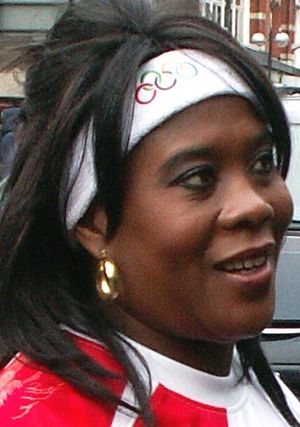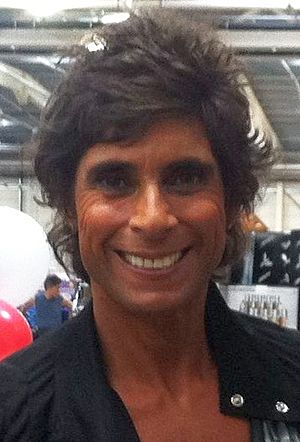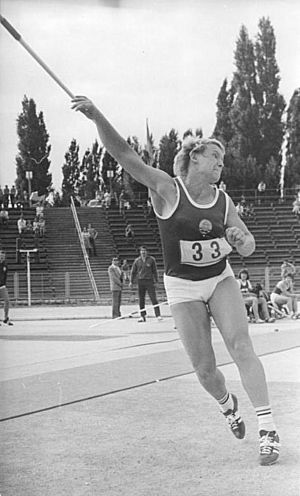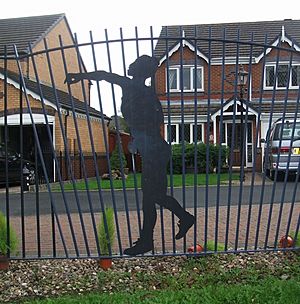Tessa Sanderson facts for kids

Sanderson in 2008
|
|||||||||||||||||||||||||||||||||||
| Personal information | |||||||||||||||||||||||||||||||||||
|---|---|---|---|---|---|---|---|---|---|---|---|---|---|---|---|---|---|---|---|---|---|---|---|---|---|---|---|---|---|---|---|---|---|---|---|
| Full name | Theresa Ione Sanderson | ||||||||||||||||||||||||||||||||||
| Nationality | British (English) | ||||||||||||||||||||||||||||||||||
| Born | 14 March 1956 St Elizabeth, Colony of Jamaica |
||||||||||||||||||||||||||||||||||
| Years active | 1973–1997 | ||||||||||||||||||||||||||||||||||
| Height | 168 cm | ||||||||||||||||||||||||||||||||||
| Weight | 70 kg | ||||||||||||||||||||||||||||||||||
| Sport | |||||||||||||||||||||||||||||||||||
| Sport | Athletics | ||||||||||||||||||||||||||||||||||
| Event(s) | Javelin throw | ||||||||||||||||||||||||||||||||||
| Club | WBAC | ||||||||||||||||||||||||||||||||||
| Achievements and titles | |||||||||||||||||||||||||||||||||||
| Personal best(s) | 73.58 m (241.4 ft) (1983) | ||||||||||||||||||||||||||||||||||
|
Medal record
|
|||||||||||||||||||||||||||||||||||
Theresa Ione Sanderson (born 14 March 1956) is a famous British athlete who was a star in the javelin throw. She competed in an amazing six Summer Olympics from 1976 to 1996. Her biggest moment came when she won the gold medal at the 1984 Summer Olympics in Los Angeles.
This incredible victory made her the first Black British woman to ever win an Olympic gold medal. She was also only the second track and field athlete in history to compete in six different Olympic Games.
Sanderson's success didn't stop there. She won three gold medals at the Commonwealth Games and a silver medal at the European Championships. Throughout her career, she had a well-known rivalry with another British javelin thrower, Fatima Whitbread.
After retiring from sports, Sanderson appeared on television and worked as a sports reporter. She also started the Tessa Sanderson Foundation and Academy. This organization helps young people and people with disabilities get involved in sports. For her amazing work, she has been honored by the Queen.
Contents
Early Life and Start in Athletics
Theresa Ione Sanderson was born in St Elizabeth, Jamaica, in 1956. When she was five, her parents moved to England to find work. A year later, she joined them in a town called Wednesfield.
In school, her physical education teacher noticed she was very talented in athletics. Her teacher encouraged her to train hard. Sanderson first tried throwing a javelin when she was 14. She made a bet with a friend for a bag of chips to see who could throw it farther. This was the start of her amazing journey.
An Amazing Athletics Career
Becoming a Champion
Sanderson joined the Wolverhampton & Bilston Athletics Club. She quickly became a top athlete in the javelin throw. By 16, she was already winning national school championships. She decided to focus completely on the javelin. This choice allowed her to travel the world for competitions.
In 1976, at age 20, she competed in her first Olympics. A year later, she made a throw of 67.20 meters. This was a new national record and the second-longest throw by a woman at that time.
She won her first major gold medal at the 1978 Commonwealth Games. Later that year, she won a silver medal at the 1978 European Championships.
After a disappointing result at the 1980 Olympics, Sanderson began working with a new coach. Sadly, she suffered serious injuries to her Achilles tendon and her throwing arm. She needed surgery and couldn't compete for almost two years. But she made a strong comeback. In 1983, she achieved her personal best throw of 73.58 meters.
Olympic Gold and Famous Rivalry
Sanderson's greatest achievement was winning the gold medal at the 1984 Summer Olympics. She set a new Olympic record with a throw of 69.56 meters. Her British teammate, Fatima Whitbread, won the bronze medal. This was the first time Great Britain had ever won an Olympic gold in a throwing event.

Sanderson and Whitbread had a famous rivalry. The British press often wrote about their competition. They pushed each other to be better athletes. Sanderson once said the rivalry "drove me to another level." Over their careers, they faced each other 45 times, with Sanderson finishing higher in 27 of those events.
Sanderson continued to compete at the highest level. She won another gold medal at the 1986 Commonwealth Games. She also competed in the 1988, 1992, and 1996 Olympics. Her appearance at the 1996 Games made her one of the few athletes to compete in six Olympics.
Throughout her career, Sanderson was strongly against the use of performance-enhancing drugs in sports. She believed in fair competition.
Life After Athletics
After retiring from sports, Sanderson stayed in the public eye. She appeared on TV shows like A Question of Sport and Surprise Surprise. She also worked as a sports reporter for Sky News.
From 1999 to 2005, she was the Vice-Chair of Sport England, an organization that promotes sports. In 2009, she started the Tessa Sanderson Foundation and Academy. The academy helps young people and people with disabilities discover their own talents in sports.
Honours and Awards
Tessa Sanderson has received many awards for her achievements.
- She was named British Athletics Writers' Association Athlete of the Year three times.
- In 1985, she was appointed a Member of the Order of the British Empire (MBE).
- She was later promoted to Officer (OBE) and then Commander (CBE) for her work in sports and charity.
- In 2012, she was added to the England Athletics Hall of Fame.
Several places are named after her, including Sanderson Park in her hometown and roads in London.
Personal Life
Sanderson has spoken about the challenges she faced as a Black woman. She experienced racism in school and received hurtful letters. She said, "Black athletes didn't have the voice they have now, so I just had to fight my own battles."
In 1986, she wrote her autobiography, Tessa: My Life in Athletics. In 1990, she won a court case against newspapers that had printed untrue stories about her.
In 2010, Sanderson married Densign White, a former Olympic athlete in judo. Her bridesmaids were fellow Olympic champions Kelly Holmes and Christine Ohuruogu. In 2013, she and her husband adopted twin babies, a boy and a girl.
Career Statistics
Personal Bests
| Event | Best | Date | Notes |
|---|---|---|---|
| Javelin throw | 73.58 m | 26 June 1983 | in Edinburgh |
| 200 m | 24.89 s | July 1981 | Brussels (European Cup semi-final) |
| 100 m hurdles | 13.46 s | 25 July 1981 | at Crystal Palace |
| High jump | 1.69 m | 13 January 1973 | at the Cosford Games |
| Long jump | 5.97 m | July 1981 | Brussels (European Cup semi-final) |
| Shot put | 13.27 m | 1981 | |
| Heptathlon | 6125 pts | July 1981 | Brussels (European Cup semi-final) |
International Competitions
The table shows Sanderson's results in major international javelin competitions.
| Year | Competition | Venue | Position | Distance |
|---|---|---|---|---|
| 1973 | European Junior Championships | Duisburg, West Germany | 12th | 39.18 m |
| 1974 | British Commonwealth Games | Christchurch, New Zealand | 5th | 48.54 m |
| European Championships | Rome, Italy | 13th (q) | 53.28 m | |
| 1976 | Olympic Games | Montreal, Canada | 10th | 57.18 m |
| 1977 | European Cup | Helsinki, Finland | 2nd | 62.36 m |
| World Cup | Düsseldorf, West Germany | 3rd | 60.30 m | |
| 1978 | Commonwealth Games | Edmonton, Canada | 1st | 61.34 m |
| European Championships | Prague, Czechoslovakia | 2nd | 62.40 m | |
| 1979 | European Cup | Turin, Italy | 3rd | 62.38 m |
| 1980 | Olympic Games | Moscow, Soviet Union | 19th (q) | 48.76 m |
| 1981 | Pacific Conference Games | Christchurch, New Zealand | 1st | 61.56 m |
| European Cup | Zagreb, Yugoslavia | 2nd | 65.94 m | |
| 1983 | World Championships | Helsinki, Finland | 4th | 64.76 m |
| 1984 | Olympic Games | Los Angeles, United States | 1st | 69.56 m |
| 1986 | Commonwealth Games | Edinburgh, United Kingdom | 1st | 69.80 m |
| 1987 | World Championships | Rome, Italy | 4th | 67.54 m |
| 1988 | Olympic Games | Seoul, South Korea | 21st (q) | 56.70 m |
| 1989 | European Cup | Gateshead, United Kingdom | 3rd | 59.72 m |
| 1990 | Commonwealth Games | Auckland, New Zealand | 1st | 65.72 m |
| European Championships | Split, Yugoslavia | 12th | 57.56 m | |
| 1991 | European Cup | Frankfurt, Germany | 1st | 65.18 m |
| 1992 | Olympic Games | Barcelona, Spain | 4th | 63.58 m |
| World Cup | Havana, Cuba | 1st | 61.86 m | |
| 1996 | European Cup | Madrid, Spain | 4th | 58.18 m |
| Olympic Games | Atlanta, United States | 14th (q) | 58.86 m | |
| 1997 | World Championships | Athens, Greece | 18th (q) | 57.84 m |
"(q)" denotes position in qualifying round.
National Titles
- 10 times AAA National Champion
- 3 times UK National Champion
See also
 In Spanish: Tessa Sanderson para niños
In Spanish: Tessa Sanderson para niños
- Javelin throw at the Olympics
- List of athletes with the most appearances at Olympic Games
- List of Olympic medalists in athletics (women)
- List of Commonwealth Games medallists in athletics (women)



